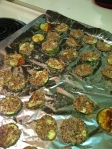About a month ago, I completed the 9-week Lurong Living Paleo Challenge. What is Paleo, you ask? It is most simply this: eat real food. More specifically, I think it is most concisely explained in this pyramid.
For me, the most challenging thing about going Paleo was that it banned pretty much everything that is convenient. And I’m not just talking about takeout or frozen dinners– something as simple as bread for my egg and sausage breakfast sandwich I typically ate on the way to work every morning. And if I ate out, things got pretty complicated, deciphering menus and finding substitutions. But overall, I simply felt better. I did notice at first that I had a little less energy when I went to workout, likely due to my body adjusting to the new diet. By the end of the challenge, it was no longer an issue.
9 weeks later, I went back to eating normally and fulfilled all my cravings. And I can honestly say it wasn’t worth it. I thought I could use what I’d learned and just be a little more liberal with my food choices– not worrying about the specifics, using ketchup or Italian dressing once in awhile, eating green beans and other things that one would consider healthy but don’t meet the Paleo criteria. But the truth was I overindulged, and I definitely felt the effects of that.
Through this challenge, I discovered I need rules and structure to be able to stick to a diet. But I also need to let myself cheat once in awhile, or I’ll binge later. For the new year, I’m resolving to get back to the primal life. As the saying goes, my goal is to be 100% paleo, 80% of the time.
Other things I learned from going Paleo:
1. To eat healthy, you MUST cook.
I spent tons of time online scouring for Paleo recipes. I highly recommend Pinterest as a source. In fact, all of the recipes I’ve tried can be found on my board “pinned there, done that” with ratings. It also doubles as my own virtual recipe book. #awesome. (See more Paleo recipes on my “Paleo things” board)
2. You also should plan your meals.
Get that convenience factor back by spending Sunday night preparing meals for the week. When you buy fruit at the grocery store, wash it and divide it into little Ziploc baggies as soon as you get home. It will make it that much easier to throw in the lunch bag.
3. There is a healthier substitute for just about everything you crave.
Mashed potatoes? Try mashed cauliflower. Pasta? try spaghetti squash. French Fries? Try cut up zucchini or turnips “breaded” with almond meal. 
4. Less is more, always.
I’ve counted calories, I’ve detoxed, I’ve done Weight Watchers, I’ve lived with two vegetarian roommates and one gluten-intolerant roommate. I’d like to think I’ve been exposed to a few diets. And the one thing I’ve noticed that they ALL have in common– real food is always the best choice. If you’re gonna eat butter, eat butter, not margarine or some other imitation product made in a lab. The less ingredients, the better. And if there’s no ingredient list, that’s the best (i.e, fruits and vegetables.) And it’s the idea behind almost every diet plan out there. (Fruits and vegetables are zero points on WW, for example.) It just makes sense.
5. Lastly, and most importantly, bacon makes everything better. That is all.
Here’s some more of my creations and experiments. I began making up my own recipes and having a lot of fun making cooking a hobby!
-

-
tomato, spices and almond meal crusted chicken breast
-

-
another typical breakfast–scrambled eggs and sausage, onion, green pepper
-

-
tacos!
-

-
chocolate zucchini bread
-

-
A typical breakfast for me. Egg whites, green pepper, bacon
-

-
zucchini noodles
-

-
zucchini fries
-

-
lemon herb chicken
-

-
pumpkin cookies with coconut
-

-
pumpkin pie
-

-
chicken pizza with almond meal crust
-

-
My most favorite meal– stuffed peppers
-

-

-
almond flour chicken nuggets
-

-
homemade guac
-

-
Avocado bacon burger
-

-
spaghetti squash, tomato sauce and meatballs
-

-
Almond crusted chicken and broccoli slaw. My own creation!
And some favorite Paleo products for my sweet tooth



Couldn’t be happier to get back on track in the new year!

























